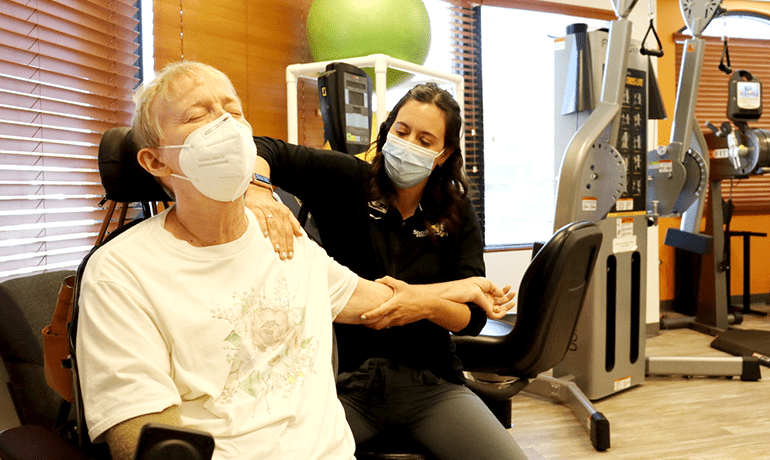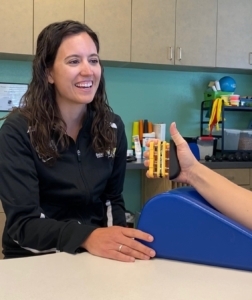Imagine you’ve been living with wrist pain and irritation for months. The ability to perform even basic tasks seems like a fond and distant memory. Typing has become your adversary, texting has become a test of will power, and thumb-wars with your nephew have become a one-sided affair. You decide it’s finally time you take matters into your own hands (pun intended) and schedule an appointment with a hand therapist.
You arrive at your appointment, anxious to begin the process of getting your wrist feeling better. The pain you experience while filling out the paperwork is both a reminder and confirmation of your decision to be there. Your therapist brings you back, and starts asking you questions about what you’re feeling.
Shortly into your appointment, your therapist turns their attention to your neck. Their questions, assessments, and measurements are all being evaluated at the neck level. You start darting your eyes from your therapist down to your wrists, trying, not-so-subtly, to guide their attention to what you came into therapy for. Your efforts fall short. Trying to remain polite and calm, you force a concerned smile across your face. Your mind starts racing, “I’m with a hand therapist, why are they looking at my neck? Have they forgotten why I’m here? Have they forgotten why they’re here? I should have brought a friend…”
Believe it or not, this is not an uncommon occurrence among patients and hand therapists. What patients may not understand, is that often times symptoms that are prevalent in the hand or wrist can actually stem from issues going on with the neck and spine.
Spooner hand therapist, Holly Hussey, MOTR/L, CHT, peels back the curtain of knowledge and explains the relationship between the neck and the wrist, and provides insight on why it’s important for patients and therapists alike to consider the question, “Is it my neck or wrist?”
Connecting The Dots Between The Neck and The Wrist
“Our entire body is connected. If you have pain in one area of your body, it can be a result of a dysfunction from somewhere else. At Spooner, we make sure to look at the whole picture,” Holly states.
This holds true for the neck/wrist relationship. The nerves that connect to your wrists and hands originate in the neck (cervical spine). Any dysfunction at the neck level can cause a disruption of function and feeling at your hands and wrists. In fact, a problem may exist with your neck, but you may only feel it in your wrists and hands.

Holly illustrates the relationship: “Think about a hose. You have water that travels from a source through a long tunnel to distribute water. This represents your nerve. If it’s pinched or damaged near the source, or in this case, your cervical spine, that’s a long way for it to travel down to your hands. That’s why a lot of times the hand and wrist is where things start when it comes to those types of symptoms, because the current has been disrupted, and the wrist and hand are so distal (distant) from where the nerve actually is intermitting. You won’t experience pain or discomfort in the neck as quickly because this current may still be getting through to the more proximal (near) joints, but not all the way down to the hand.”
Are There Other Neck Conditions That May Contribute To Wrist Discomfort?
“Nerve compression is the most common, but joint tightness in your cervical spine (neck) or thoracic spine (mid-back) can also cause issues with the way you use your arms,” Holly describes. “If you can’t turn your head or body enough when reaching for something behind or beside you, you may overextend or compensate by putting your wrist, hand, elbow or shoulder in a position that it wouldn’t naturally go in. This can cause soft tissue issues that cause pain.”
Furthermore, this relationship works both ways. Because our entire body is connected, an injury to the hand or wrist can, in turn, cause neck or shoulder pain. “Neck and shoulder pain can occur when someone has acutely injured their wrist, such as a wrist fracture, and the patient doesn’t use their shoulder normally or they position their body in a way that guards the injury. The guarded use of the arm and abnormal positioning can cause neck pain,” Holly explains.
Regardless if the symptoms are stemming from your neck or wrists, it’s important to work with a hand therapist to ensure the root of the problem is taken care of before symptoms and deficiencies begin affecting other areas of the body.
Is There Anything I Can Do To Help Relieve This Discomfort On My Own?
Because every individual and injury are unique, it can be difficult to recommend anything too specific; however, Holly offers a few suggestions for folks to try at home or work if they’re feeling discomfort in their neck or wrist.
“We don’t recommend staying in a sustained position for longer than 20 minutes. If you’re sitting at work, riding your motorcycle, or driving, etc. you should be switching up your posture every 20 minutes: shifting, moving, stretching, doing different things to help reduce the compression of the nerves.”
In addition, Holly emphasizes the importance of maintaining proper posture. “Make sure you are sitting up straight and not hunching the shoulders. Hunching the shoulders forward would probably be the main culprit causing pain and nerve impingements.”
Read more about exercises to fix hunched shoulders in Are Hunched Shoulders Causing You Pain? on the Spooner Blog!
When Should I Seek Physical/Hand Therapy?
If you are experiencing tingling, numbness, pain, and/or decreased strength in your wrists and hands, and the above recommendations are not reducing the discomfort, then you should make an appointment to see a hand therapist. Holly states, “If movement and postural adjustments aren’t working, then you probably need specific exercises and treatment to help you with your symptoms.” Neck and wrist pain are rarely isolated incidents, and it’s important to make sure your entire body is working and feeling the way it’s supposed to.
As Holly highlights, “It really requires a full-body assessment, which is just really hard for patients do for themselves. If you’re having symptoms, we’ll help identify the source and work together to help get you moving and feeling better!”
Learn more about Hand Therapy at Spooner Physical Therapy. Ready to schedule an appointment? Schedule an appointment or complimentary movement screen with a Spooner physical therapist at one of our locations throughout the valley.


